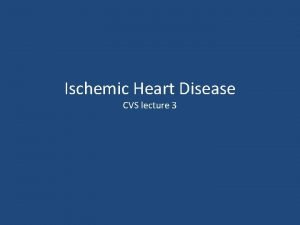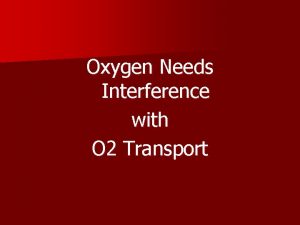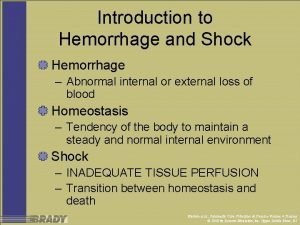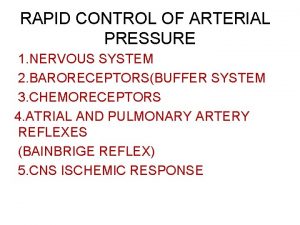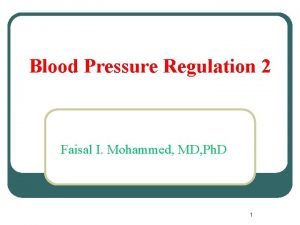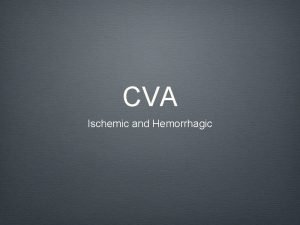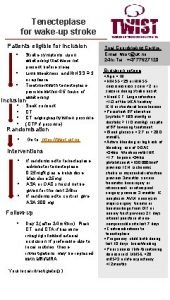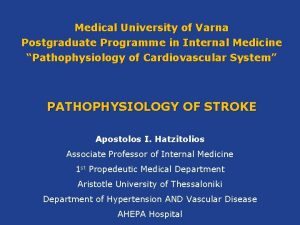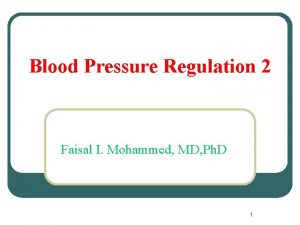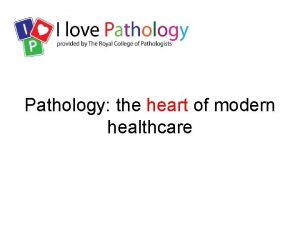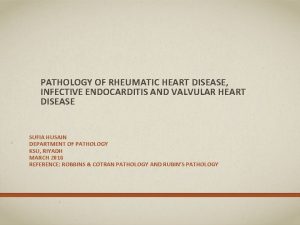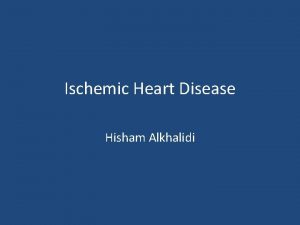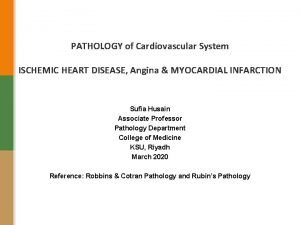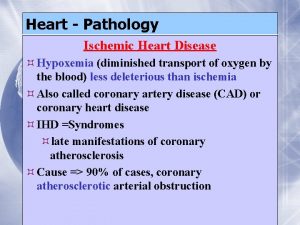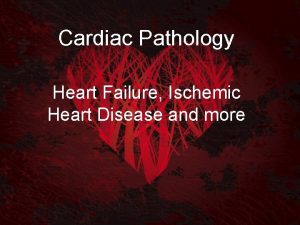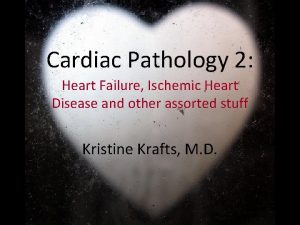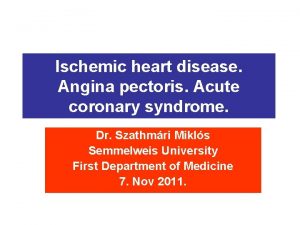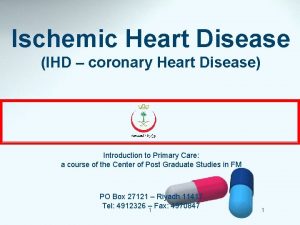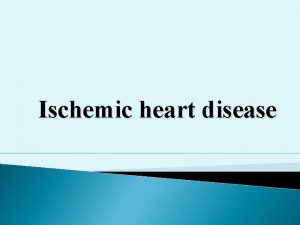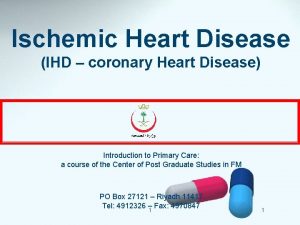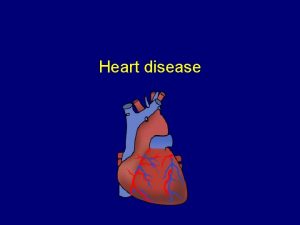Pathology teamwork Lecture 3 Ischemic heart disease angina

















- Slides: 17

Pathology teamwork Lecture (3): Ischemic heart disease, angina, and MI. Editing File Color Index : ▪VERY IMPORTANT ▪Extra explanation ▪Examples ▪Diseases names: Underlined ▪Definitions ﺭﺃﻰ ﺃ ﺑﺬ ﺍﻟﺠﻬ ﺍﺟﺘﻬﺎﺩﺍ ، *ﻭﺇ ﺍﻟ ﻣﻬﻨ

▪Understand the pathogenesis and clinical consequences of atherosclerosis. Objectives : ▪Be able to discuss pathology and complications of ischemic heart diseases with special emphasis on myocardial infarction ▪Know how lifestyle modifications can reduce the risk of ischemic heart diseases. Key principles to be discussed: ▪Risk factors of atherosclerosis. ▪Pathogenesis of the fibro lipid atherosclerotic plaque. ▪Clinical complications of atherosclerosis. ▪Commonest sites for the clinically significant coronary atherosclerosis. ▪Macroscopic and microscopic changes in myocardial infarction. ▪Biochemical markers of myocardial infarction. ▪Complications of myocardial infarction: immediate and late.

Ischemic Heart Disease/IHD (Coronary Heart Disease) IHD = A group of closely related conditions/syndromes caused by an imbalance between the myocardial oxygen demand blood supply. Usually caused by decreased coronary artery blood flow (“coronary artery disease”) Four syndromes: Angina pectoris (Chest Pain) Acute Myocardial Infarction Sudden Cardiac Death Chronic ischemic heart disease with congestive heart failure The most common cause of IHD is coronary artery atherosclerosis. Less commonly it is due to vasospasm and vasculitis. Epidemiology ● ● ● Peak incidence: 60 y for males and 70 y for females. Men are more affected than women. Contributing factors are same as that of atherosclerosis e. g. ○ Hypertension ○ Diabetes mellitus ○ Smoking ○ High levels of LDL ○ Genetic factors (direct or indirect) ○ Lack of exercise Pathogenesis Role of Critical stenosis or obstruction Role of Acute Plaque Change Role of Coronary Thrombus Role of Vasoconstriction Role of Inflammation -Ischemic heart disease is caused by atherosclerosis, which means insufficient blood supply to the myocardium. -Myocardial infarction full obstruction no blood supply

Pathogenesis of Ischemic Heart Disease 1. Role of Critical stenosis or obstruction: (>=75% of the lumen of one or more coronary arteries by atherosclerotic plaque). 2. Role of Acute Plaque Change: ● Disruption of a mildly stenosing plaque leading to rupture/ ulceration. This can lead to: ○ Hemorrhage into the atheroma which will expand in volume. ○ Exposure of the thrombogenic basement membrane just below the endothelial lining followed by thrombosis ● Acute plaque change can cause myocardial ischemia in the form of: ○ Unstable angina ○ Acute myocardial infarction ○ (in many cases) Sudden cardiac death Acute plaque change → rupture/ulceration → thrombus formation → total blockage → myocardial infarction → hypoxia → cell injury (reversible or irreversible) (if irreversible → coagulation necrosis) as in MI

3. Role of Coronary Thrombus: ● ● Thrombus superimposed on a disrupted partially occluding plaque can convert the plaque to either ○ A total occlusion leading to acute transmural MI. (full thickness of the muscle) ○ Or a partial/incomplete/subtotal occlusion leading to unstable angina, acute subendocardial infarction, or sudden cardiac death. Thrombus in coronary artery can also embolize. 4. Role of Vasoconstriction: Vasoconstriction reduces lumen size and can therefore potentiate plaque disruption. 5. Role of Inflammation: Inflammatory processes play important roles at all stages of atherosclerosis. Plaque rupture without superimposed thrombus in a patient who died suddenly. 90% obstruction Acute coronary thrombosis superimposed on an atherosclerotic plaque with focal disruption of the fibrous cap, triggering fatal myocardial infarction. Full obstruction Important picture

Ischemic Heart Disease Four closely related conditions/syndromes that come under IHD are: Angina pectoris “chest pain” * Acute myocardial infarction “MI”* Sudden cardiac death. Chronic ischemic heart disease with congestive heart failure. *both angina pectoris and MI has ischemia and hypoxia but the difference between them is that the ischemia in angina pectoris is not enough to cause necrosis while in MI the ischemia will cause necrosis. Angina pectoris ● Angina pectoris is a type of IHD characterized by paroxysmal (episodes) and usually recurrent attacks of substernal or precordial chest discomfort, described as constricting, crushing, squeezing, choking, or knifelike pain. The pain may radiate down the left arm or to the left jaw *(called as referred pain(pain felt in a part of the body other than its actual source)). ** ● Angina pectoris is due to inadequate perfusion and is caused by transient (not continuous)(15 seconds to 15 minutes) myocardial ischemia that falls short of inducing the cellular necrosis that defines infarction i. e. duration and severity is not sufficient for infarction*** ● There are three types of angina pectoris: a. Stable or typical angina b. Unstable or crescendo angina c. Prinzmetal or variant angina *Why the left side? because the heart is lying on the left side **The patient will complain of episodic substernal pain described as knifelike pain which radiate to the left arm, neck or jaw ***there will be a non continuous ischemia lasts for 15 sec to 15 min which is not enough to cause necrosis “ there is no necrosis in angina pectoris”

a. Stable/ typical angina pectoris: * ● ● is the most common form of angina. It is caused by atherosclerotic disease with usually ≥ 70% to 75% narrowing of lumen i. e. (critical stenosis or fixed chronic stable stenosis). This reduction (70 to 75% stenosis) of coronary vessels makes the heart vulnerable(exposed to the possibility of being attacked or harmed, either physically or emotionally), so whenever there is increased demand, e. g. physical activity, emotional excitement, or any other cause of increased cardiac workload, there is angina pain. The chest pain is episodic and associated with exertion or some other form of stress. Is usually relieved by rest (thereby decreasing demand) or with a strong vasodilator like nitroglycerin. ● ● ● b. Unstable or crescendo (increasing) angina: ● ● It is an unstable and progressive condition. Pain occurs with progressively increasing frequency**, and is precipitated with progressively less exertion, even at rest, and tends to be of more prolonged duration. It is induced by disruption or rupture of an atheroma plaque with superimposed partial thrombosis. Unstable angina is often the precursor of subsequent acute MI. Thus also called as preinfarction angina (“morning sign of heart attack” that’s why we can’t send the patient home) c. Prinzmetal variant angina ● ● is an uncommon pattern of episodic angina that occurs at rest and is due to coronary artery spasm. Prinzmetal angina generally responds promptly to vasodilators, such as nitroglycerin and calcium channel blockers. Not related to atherosclerotic disease The etiology is not clear. EXTRA Pic *The patient will have an episodic attack of pain after any exertion or some other form of stress and will be relieved by rest and nitroglycerin **The patient before, has the pain during climbing stairs But then, the pain comes during walking then during standing and then it start even at rest IMPORTANT: -A lesion obstructing 70%-75% or more of a vessel lumen so called critical stenosis, generally causes symptomatic ischemia (angina) only in the setting of increased demand -A fixed 90% stenosis can lead to inadequate coronary blood flow even at rest In most patients, unstable angina, infarction occur because of abrupt plaque change “rupture, fissuring or ulceration” followed by thrombosis

Myocardial Infarction (MI) Definition: MI, also known as "heart attack, " is the death of cardiac muscle (coagulative necrosis) resulting from ischemia. Risks are the same as those of coronary atherosclerosis. The commonly affected coronary vessel in MI in persons with right dominant coronary artery heart (90% of population) are: ❖ Left anterior descending artery (40 -50%) ❖ Right coronary artery (30 -40%) ❖ Left circumflex artery (about 20%) Pathogenesis of MI Most common cause is thrombosis on a preexisting disrupted atherosclerotic plaque. In the typical case of MI, the following sequence of events usually occur: Acute plaque change (sudden change in the structure of an atheromatous plaque e. g. disruption, ulceration, rupture or intraplaque hemorrhage). Exposure of the thrombogenic subendothelial basement membrane resulting in thrombus formation. Frequently within minutes, the thrombus evolves to completely occlude the lumen of the coronary vessel. ❖ Severe ischemia lasting at least 20 to 40 minutes causes irreversible injury and myocardial necrosis on the ultrastructural level (on electron microscopy). ❖ Myocardial necrosis mostly starts in the sub-endocardial region (because it is less perfused and has high intramural pressure). It’s begins within 20 -30 minutes. ❖ The full size of the infarct is usually determined within 3 -6 hours (mainly 4 hours) of the onset of severe myocardial ischemia. During this period, lysis of the thrombus by streptokinase* or tissue plasminogen activator**, may limit the size of the infarct. So any intervention in this time frame can potentially limit the final extent of necrosis. Treatment up to 6 hours may help. After 6 hours, no response. *streptokinase used to break down clots. ** Plasminogen is the precursor of plasmin, which lyses fibrin clots to fibrin. -MI is a complete obstruction due to atherosclerosis that lead to thrombosis.

Pathogenesis of MI The precise location, size, and specific morphologic features of an acute myocardial infarct depend on: 1. The location, severity, and rate of development of coronary atherosclerotic obstructions 2. The size of the area supplied by the obstructed vessels 3. The duration of the occlusion 4. The oxygen needs of the myocardium at risk 5. The extent of collateral blood vessels 6. Other factors, such as blood vessel spasm, alterations in blood pressure, heart rate, and cardiac rhythm. 7. In addition reperfusion may limit the size of the infarct. Collateral circulation MI types and morphology ❖ TYPES: 1. Transmural: Full thickness (>50% of the wall). 2. Subendocardial: Inner 1/3 of myocardium. ❖ MORPHOLOGY: -Begins with coagulative necrosis and inflammation (initially mainly neutrophils and later macrophages). -Followed by formation of granulation tissue. Heals by formation of a fibrous scar.

Morphologic Changes in Myocardial Infarction Gross changes Microscopic changes 0 - 4 h None, by electron microscope you see necrosis (not seen in LM) 4 - 12 h Mottling ﺗﺒﻘﻊ Coagulation necrosis Mottling More coagulation necrosis; neutrophils come in 2 - 7 d Yellow infarct center Neutrophils die, macrophages come to eat dead cells 1 - 2 w Yellow center, red borders Granulation tissue 2 - 8 w Scar collagen (fibrosis) Time 12 - 24 h

Acute Myocardial Infarction MI: day 1, day 3, day 7 Microscopic features of myocardial infarction A. One-day-old infarct showing coagulative necrosis with few neutrophils, wavy fibers with elongation, and narrowing, compared with adjacent normal fibers (lower right). B. Dense neutrophilic infiltrate in an area of acute myocardial infarction of 3 to 4 days' duration. C. Nearly complete removal of necrotic myocytes by phagocytosis (approximately 7 to 10 days). (A) (B) (C ) Granulation tissue approximately 3 weeks post MI Healed MI with replacement of the necrotic fibers by dense collagenous scar. Residual cardiac muscle cells are present

Myocardial Infarction: Clinical Features ❏ ❏ ❏ Pain: Severe crushing sub-sternal chest pain, which may radiate to the neck, jaw, epigastrium, shoulder or left arm. Pain lasts for hours to days and is not relieved by nitroglycerin. Sublingual to minimize pain. No pain in 20 -30% of patients (diabetics, hypertensive, elderly). Pulse is rapid and weak. Diaphoresis (sweating) , Dyspnea. Cardiogenic shock can be seen in massive MI (>40% of lt. ventricle). ECG shows typical findings of ischemia. Ischemic Heart Disease Laboratory evaluation 1 - Troponins: best marker, Tn. T, Tn. I (more specific). ❖ ❖ Time is important Tn. I and Tn. T are not normally detectable in the circulation After acute MI both troponins become detectable after 2 to 4 hours, peaks at 48 hours. Their levels remain elevated for 7 to 10 days 2 - CK-MB is the second best marker: ❖ It begins to rise within 2 to 4 hours of MI, peaks at 24 to 48 hours and returns to normal within approximately 72 hours. So at day 3, if you find normal CK-MB; it doesn't mean that your patient doesn’t have MI. 3 - Lactate dehydrogenase (LD)… LD 1. ❖ Rise 24 hrs, peaks 72 hrs, persists 72 hrs. Myocardial Infarction: Outcomes or complications ❏ ❏ ➢ ➢ ➢ ➢ No complications in 10 -20%. 80 -90% experience one or more of the following complications: Cardiac arrhythmia* (75 -90%). Patients have conduction disturbances and myocardial irritability which can lead to sudden death especially in ventricular arrhythmia. Left ventricular failure with mild to severe pulmonary edema (60%). Myocardial rupture**: Rupture of free wall, septum, rupture of papillary muscle (leading to papillary muscle and associated valve incompetence/dysfunction) Thromboembolism (15 -49%): the combination of myocardial abnormality in contractility (causing stasis) and endocardial damage (due to exposure of underlying thrombogenic basement membrane) can lead to cardiac thrombosis and embolism Pericarditis , Progressive late heart failure in the form of chronic IHD. Infarct extension and expansion, Cardiogenic shock (10%). Ventricular aneurysm in which the ventricle is dilated and the wall is thinned out. External rupture of the infarct with associated bleeding into the pericardial space (hemopericardium). -MI may be asymptomatic. For example, diabetics having MI most likely won’t develop chest pain. *Most common cause of sudden death. ** Leading to hemorrhage & could cause death.

Chronic ischemic heart disease & Sudden cardiac death Chronic ischemic heart disease Progressive heart failure due to ischemic injury, either from: ▪ prior infarction(s) (most common) ▪ or chronic low-grade ischemia Sudden cardiac death • • Unexpected death from cardiac causes either without symptoms or within 1 to 24 hours of symptom onset. Results from ; a fatal arrhythmia, most commonly in patients with severe coronary artery disease

Summary

Questions IMPORTANT 1 - A 50 -year-old man who had an experience of episodes of severe substernal chest pain every time he performs a task that requires moderate exercise. What is the diagnosis? - Typical angina pectoris 2 - What is the finding in the coronary artery ? - Atherosclerosis narrowing exceeds 75%. 3 - What are the risk factors of this disease ? - Diabetes mellitus, hypertension, hyperlipidemia, smoking, Age, male, genetics familial 4 - What is the pathogenesis for this? - Endothelial cell injury 5 - What are possible complications for this disease? - Cerebral infarction, myocardial infarction , aortic aneurysm, gangrene ……etc 6 - After a period of time , The previous patient had chest pain even at rest? - Unstable (preinfarction) angina 7 - What are the expected findings in the coronary artery? - plaque disruption and thrombosis 8 - Now the patient suffer from Severe crushing substernal chest pain, which radiate to the left shoulder and arm. ECG showed findings of myocardial infarction. What blood test support this diagnosis? - Troponin and CK-MB 9 - After 4 days, which one of these blood tests is positive and which one is negative? - Troponin will be +ve and CK-MB will be -ve 10 - What are the possible complications of myocardial infarction? - Arrhythmia, Left ventricular failure , Cardiogenic shock , Thromboembolism …etc 11 - What are the microscopic findings in the first 30 minutes of myocardial infarction? - No microscopic findings 12 - Coagulation necrosis starts after which period of time of MI? - 4 hours


Kindly contact us if you have any questions/comments and suggestions: * EMAIL: pathology 437@gmail. com * TWITTER : @pathology 437 GOOD LUCK ! ☺ Pathology teamwork *references: - Robbins Basic Pathology - Slides
 Pathophysiology of ischemic heart disease
Pathophysiology of ischemic heart disease Chronic coronary syndrome
Chronic coronary syndrome Heart disease
Heart disease Lingsard
Lingsard Poem about working together as a team
Poem about working together as a team Crohn's disease pathology outlines
Crohn's disease pathology outlines Ischemic bile duct injury
Ischemic bile duct injury Optic ischemic neuropathy
Optic ischemic neuropathy Cns ischemic response
Cns ischemic response Cns ischemic response flow chart
Cns ischemic response flow chart Stroke protocol
Stroke protocol Cns ischemic response
Cns ischemic response Hemorrhagic vs ischemic stroke symptoms
Hemorrhagic vs ischemic stroke symptoms Wake up stroke
Wake up stroke Mechanism of ischemic stroke
Mechanism of ischemic stroke Cns ischemic response
Cns ischemic response Heart
Heart Jones criteria
Jones criteria
